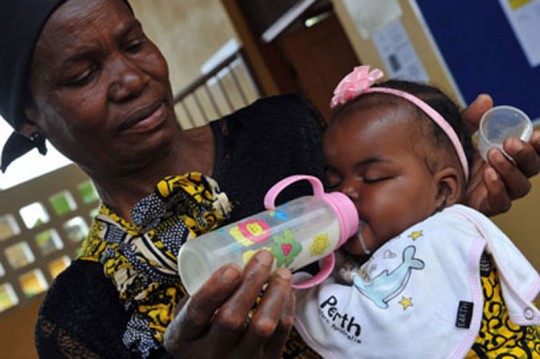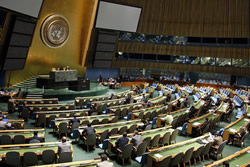On World AIDS Day, UN officials say end to epidemic is within reach
On World AIDS Day, UN officials say end to epidemic is within reach
 Isabel is a grandmother in Mozambique who cares for her 6 months old granddaughter whose mother died of an AIDS-related illness
Isabel is a grandmother in Mozambique who cares for her 6 months old granddaughter whose mother died of an AIDS-related illness
1 December 2011 – As the world heads into the fourth decade of AIDS, it is finally in a position to end the epidemic, Secretary-General Ban Ki-moon said today, leading a chorus of United Nations officials in calling for the political will, investments and determination to reach this goal.
“Momentum is on our side. Let us use it to end AIDS – once and for all,” Mr. Ban said in his message for World AIDS Day, observed on 1 December each year.
“The progress we have made so far is proof that we can realize our vision of zero new HIV infections, zero discrimination and zero AIDS-related deaths,” he added.
The number of new HIV infections has fallen by more than 20 per cent since 1997, Mr. Ban noted. New infections are continuing to decline in most parts of the world. In addition, treatment has averted 2.5 million AIDS-related deaths since 1985, saving 700,000 lives last year alone.
“But, to end AIDS, we need to deliver even greater results,” stressed the Secretary-General. “We must build on the political commitments, investments, energy, activism and determination that have brought us to this turning point.”
Michel Sidibé, Executive Director of the Joint UN Programme on HIV/AIDS (UNAIDS), noted it has been a year of achievements, of collective action, of resilience and of courage. Despite the economic downturn that has stretched the AIDS response to its limits, millions of lives have been saved, as HIV treatment and prevention efforts continue to show results, he said.
…
Annie Lennox and Michel Sidibé call upon you to bring an end to AIDS.
As we mark 30 years of AIDS, let’s be inspired by the early days of AIDS activism. AIDS has proven to be much more than an epidemic—it is a movement that has inspired people across the world and well beyond the sphere of health. This movement is more important now than ever. The beginning of the end of AIDS is now in sight — we must get to Zero new HIV infections, Zero discrimination, Zero AIDS related deaths. It is our shared responsibility, in memory of the millions who died of AIDS but also for the future generations.
…
“Never before in the history of AIDS have we reached a moment where we are able to stand up and say with conviction the end of AIDS is in sight,” he stated in his message.
“The road before us is clear and we can accelerate ahead with smart investments, capitalizing on scientific advancements and evidence and respecting human rights,” Mr. Sidibé said, calling on countries, donors and others to reach the global investment target of $22-24 billion for the AIDS response. “Only together can we secure the future and provide greater and long-term dividends.”
In a related development, Mr. Sidibé welcomed China’s decision to fill its HIV resource gap by increasing domestic investments. The new commitment from China comes at a crucial moment, according to UNAIDS, as resources for AIDS are declining and the Global Fund to Fight AIDS, Tuberculosis and Malaria is facing a major setback in resource mobilization.
The theme of this year’s World AIDS Day is “Getting to Zero,” which reflects both optimism and the need to do much more, the President of the General Assembly said in his message, noting that the challenges ahead are “sobering.”
While more than 6.5 million people now receive life-saving treatment, 7.6 million still have no access to it, said Nassir Abdulaziz Al-Nasser. In 2010 alone, 1.8 million people died of AIDS-related illnesses, and there were 2.7 million new HIV infections.
“We cannot allow hard-won gains to unravel,” said Mr. Al-Nasser. “I call on all stakeholders to uphold their commitments, and to work together to sustain and accelerate the progress.”
A number of other senior UN officials issued messages, adding their voices to the call for sustained action to finally rid the world of the epidemic. They include the Executive Director of the UN Office of Drugs and Crime (UNODC), Yury Fedotov; the Director-General of the UN Educational, Scientific and Cultural Organization (UNESCO), Irina Bokova; and the Director-General of the International Labour Organization (ILO), Juan Somavia.
The UN World Food Programme (WFP) marked the Day by emphasizing the importance of providing food and nutrition support to people living with HIV and their families.
“Poor nutritional status and HIV can reinforce each other in a vicious circle,” said Martin Bloem, WFP’s chief of nutrition and HIV/AIDS policy. “WFP works with communities and health centres around the world to ensure that people affected by HIV and AIDS receive comprehensive support that nourishes and strengthens their bodies.”
In 2010, WFP supported 2.5 million people in 44 countries through its HIV and tuberculosis programmes, providing food and nutrition support to some 1.3 million people living with HIV as part of their antiretroviral treatment (ART) or TB treatment and another 1.2 million people affected by these diseases. It aims to reach about the same number of people this year.
Yesterday, the UN World Health Organization (WHO), the UN Children’s Fund (UNICEF) and UNAIDS released their report on the global HIV/AIDS response, highlighting the fact that there is a very real possibility of getting ahead of the epidemic.
This can only be achieved, however, by both sustaining and accelerating the current momentum over the next decade and beyond, the agencies stressed.
Meanwhile, a UN Development Programme (UNDP) study released today says that households in Asia that include people living with HIV exhaust their savings and liquidate assets at a disproportionately high rate, often plunging into “irreversible poverty.”
Catastrophic health care costs, stigma, unemployment, and bad credit also mean these households – which start out with fewer assets – consume less food of lower quality and keep fewer children in school, said the report, which calls for urgent mitigation measures, including HIV-sensitive social protection to help tens of thousands of households in the region.
###
1 December 2011
RESULTS OF FULLY FUNDING UNAIDS TARGET WOULD OFFSET COSTS IN LESS THAN ONE GENERATION,
SECRETARY-GENERAL SAYS IN MESSAGE FOR WORLD AIDS DAY
Following is UN Secretary-General Ban Ki-moon’s message for World AIDS Day, observed on 1 December:
Heading into the fourth decade of AIDS, we are finally in a position to end the epidemic. The progress we have made so far is proof that we can realize our vision of zero new HIV infections, zero discrimination and zero AIDS-related deaths.
The number of new HIV infections has fallen by more than 20 per cent since 1997. New infections are continuing to decline in most parts of the world. In sub-Saharan Africa, the region most affected by the AIDS epidemic, HIV incidence has decreased in 22 countries.
Among populations at risk, the tide is shifting. Access to HIV prevention services are helping young people, sex workers and their clients, people who inject drugs, men who have sex with men, and transgender people to take control of their health for greater well-being.
Treatment has averted 2.5 million AIDS-related deaths since 1985. Last year alone, 700,000 lives were saved. Some 6.6 million people, nearly half those who need treatment in low- and middle-income countries, are now receiving it. Synergies between prevention and treatment are speeding up progress. But, to end AIDS, we need to deliver even greater results.
This year in June, the United Nations General Assembly’s High-Level Meeting on AIDS adopted bold targets for 2015: reduce the sexual transmission of HIV by half; eliminate new infections in children; provide treatment for 15 million people living with HIV; end stigma and discrimination; and close the AIDS funding gap. With strong political will, reasonable financial resources and a firm human rights-based approach, we can achieve all of these targets.
Financing will be critical to success. I urge all concerned to act on the investment framework put forward by UNAIDS and to fully fund the global investment target of up to $24 billion annually. The results would offset the upfront costs in less than one generation. We must build on the political commitments, investments, energy, activism and determination that have brought us to this turning point. Momentum is on our side. Let us use it to end AIDS — once and for all.
###
> United Nations (UN).
 The United Nations was established on 24 October 1945 by 51 countries committed to preserving peace through international cooperation and collective security. Today, nearly every nation in the world belongs to the UN: membership totals 192 countries.
The United Nations was established on 24 October 1945 by 51 countries committed to preserving peace through international cooperation and collective security. Today, nearly every nation in the world belongs to the UN: membership totals 192 countries.
When States become Members of the United Nations, they agree to accept the obligations of the UN Charter, an international treaty that sets out basic principles of international relations. According to the Charter, the UN has four purposes:
- to maintain international peace and security;
- to develop friendly relations among nations;
- to cooperate in solving international problems and in promoting respect for human rights;
- and to be a centre for harmonizing the actions of nations.
###
* The above story is adapted from materials provided by United Nations (UN)
** More information at United Nations (UN)



















